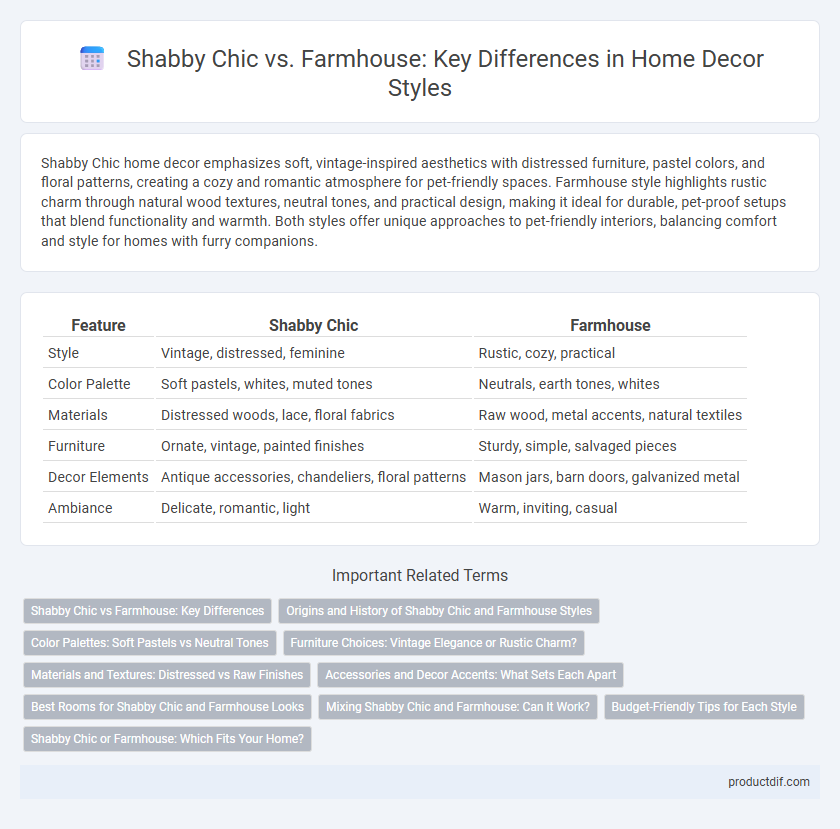Shabby Chic home decor emphasizes soft, vintage-inspired aesthetics with distressed furniture, pastel colors, and floral patterns, creating a cozy and romantic atmosphere for pet-friendly spaces. Farmhouse style highlights rustic charm through natural wood textures, neutral tones, and practical design, making it ideal for durable, pet-proof setups that blend functionality and warmth. Both styles offer unique approaches to pet-friendly interiors, balancing comfort and style for homes with furry companions.
Table of Comparison
| Feature | Shabby Chic | Farmhouse |
|---|---|---|
| Style | Vintage, distressed, feminine | Rustic, cozy, practical |
| Color Palette | Soft pastels, whites, muted tones | Neutrals, earth tones, whites |
| Materials | Distressed woods, lace, floral fabrics | Raw wood, metal accents, natural textiles |
| Furniture | Ornate, vintage, painted finishes | Sturdy, simple, salvaged pieces |
| Decor Elements | Antique accessories, chandeliers, floral patterns | Mason jars, barn doors, galvanized metal |
| Ambiance | Delicate, romantic, light | Warm, inviting, casual |
Shabby Chic vs Farmhouse: Key Differences
Shabby Chic emphasizes distressed furniture with a soft, pastel color palette and vintage accessories to create a romantic, worn-in look. Farmhouse style focuses on rustic, practical elements, featuring natural wood, neutral tones, and sturdy, functional furniture. The key difference lies in Shabby Chic's delicate, ornate aesthetic versus Farmhouse's cozy, utilitarian design.
Origins and History of Shabby Chic and Farmhouse Styles
Shabby Chic originated in 1980s England, inspired by vintage aesthetics and the charm of well-worn furniture with distressed finishes that evoke a sense of nostalgia and romanticism. Farmhouse style traces back to rural American homes of the 18th and 19th centuries, emphasizing practicality, natural materials, and a cozy, lived-in atmosphere rooted in agricultural traditions. Both styles celebrate simplicity but differ in their historical contexts, with Shabby Chic highlighting feminine elegance and Farmhouse reflecting rustic, utilitarian heritage.
Color Palettes: Soft Pastels vs Neutral Tones
Shabby Chic home decor features soft pastels such as blush pink, mint green, and pale blue, creating a delicate and vintage-inspired atmosphere. Farmhouse style relies on neutral tones like beige, cream, white, and gray, emphasizing a rustic, natural, and cozy feel. These contrasting color palettes define the mood of each decor style and guide furniture and accessory choices.
Furniture Choices: Vintage Elegance or Rustic Charm?
Shabby Chic furniture emphasizes vintage elegance with distressed finishes, pastel colors, and ornate details, creating a soft, romantic ambiance. Farmhouse furniture showcases rustic charm through sturdy wood pieces, natural textures, and a practical, worn-in feel that highlights simplicity and comfort. Choosing between these styles depends on whether you prefer the delicate, nostalgic allure of Shabby Chic or the warm, rugged authenticity of Farmhouse design.
Materials and Textures: Distressed vs Raw Finishes
Shabby Chic home decor features distressed materials and soft textures, emphasizing worn paint, chipped wood, and vintage fabrics that create a romantic, aged appearance. Farmhouse style highlights raw finishes with natural wood, exposed beams, and unrefined metals, offering a rugged yet warm ambiance. Both styles prioritize tactile surfaces but differ in the intention behind their imperfect finishes--Shabby Chic embraces delicate aging, while Farmhouse celebrates raw authenticity.
Accessories and Decor Accents: What Sets Each Apart
Shabby Chic accessories often feature distressed finishes, floral patterns, and vintage-inspired details, creating a soft, romantic ambiance with elements like lace-trimmed cushions and antique picture frames. Farmhouse decor accents emphasize rustic materials such as galvanized metal, reclaimed wood, and mason jars, showcasing utilitarian charm through items like barn-style signs and weathered lanterns. The key difference lies in Shabby Chic's delicate, ornate character versus Farmhouse's sturdy, country-inspired aesthetic.
Best Rooms for Shabby Chic and Farmhouse Looks
Shabby Chic style thrives in bedrooms and living rooms where soft pastels, distressed furniture, and vintage accessories create a cozy, romantic atmosphere. Farmhouse decor excels in kitchens and dining areas, featuring rustic wood elements, neutral tones, and practical yet charming accents like mason jars and open shelving. Both styles transform spaces by emphasizing comfort and a lived-in feel tailored to their unique aesthetic.
Mixing Shabby Chic and Farmhouse: Can It Work?
Mixing Shabby Chic and Farmhouse styles can create a harmonious and inviting home decor by blending the soft, distressed elegance of Shabby Chic with the rustic, cozy appeal of Farmhouse design. Key elements like vintage furniture with worn paint, natural wood textures, and neutral color palettes facilitate a seamless fusion that highlights both charm and simplicity. Emphasizing layered textiles, antique accessories, and reclaimed materials ensures the combined aesthetic maintains balance without overwhelming the space.
Budget-Friendly Tips for Each Style
Shabby Chic offers budget-friendly charm through thrifted furniture refinished with whitewash paint and inexpensive floral fabrics for cushions and curtains. Farmhouse style saves costs by utilizing reclaimed wood for tables and shelves, paired with simple, durable textiles like burlap and cotton in neutral tones. Both styles emphasize DIY projects and repurposed materials to create affordable, cozy home decor.
Shabby Chic or Farmhouse: Which Fits Your Home?
Shabby Chic emphasizes distressed furniture, pastel colors, and vintage accessories to create a soft, romantic atmosphere, while Farmhouse style features rustic wood, neutral tones, and practical, cozy elements reflecting country living. Choose Shabby Chic for a delicate, nostalgic vibe with floral patterns and antique details; opt for Farmhouse if you prefer a warm, inviting space with natural textures and industrial accents. Both styles offer unique charm, so consider your home's architecture and personal taste to find the perfect fit.
Shabby Chic vs Farmhouse Infographic

 productdif.com
productdif.com